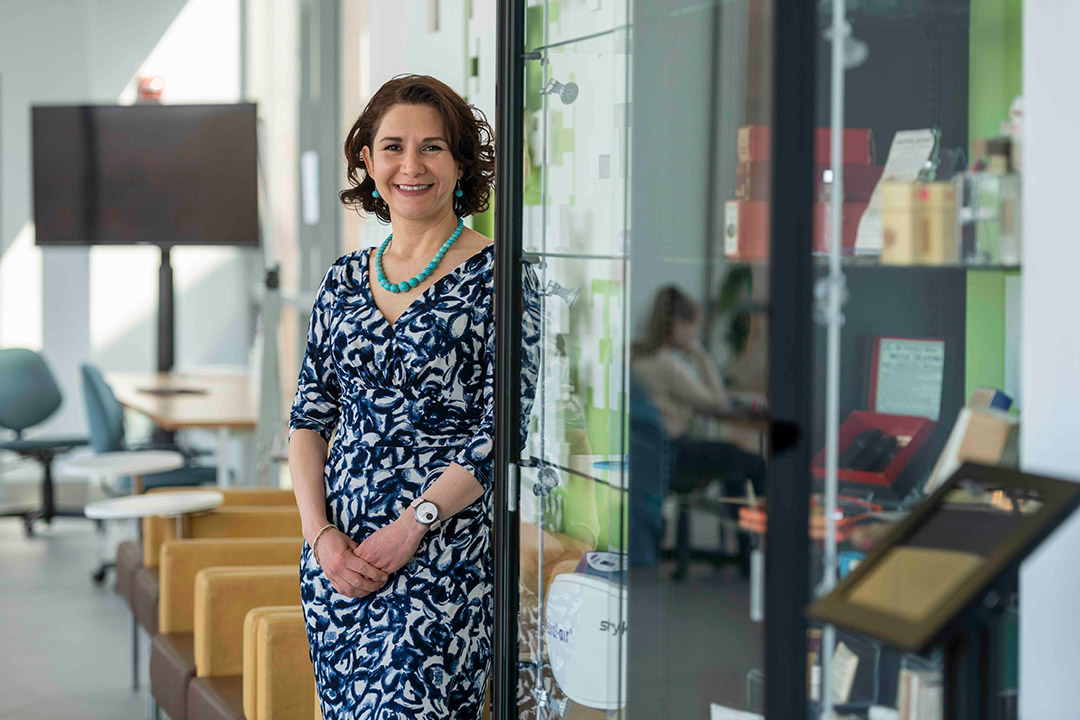New micro-technique to differentiate pathogens faster discovered by RIT researcher
Blanca Lapizco-Encinas develops new application for lab-on-chip devices to identify microparticles resistant to current treatments
Elizabeth Lamark/RIT
Biomedical Engineering Professor Blanca Lapizco-Encinas is developing a new micro-technique to differentiate disease-causing pathogens faster for lab-on-chip applications.
Pathogens like E. coli and SARS-Cov2 mutate and are often resistant to current vaccinations.
RIT researcher Blanca Lapizco-Encinas found new ways to identify those mutations faster. Resurrecting an older theoretical technique that can be used for analyzing pathogens that cause disease, her work could improve how clinicians develop more effective treatments.
“Remember the challenges we had with covid and its variations and mutations? The vaccines were not effective for the mutations. For some things, time is of the essence. You need to make decisions quickly,” said Lapizco-Encinas, a professor of biomedical engineering in RIT’s Kate Gleason College of Engineering.
Pathogens including those with mutations, respond immediately to electrical fields used for analysis and separation. Refining this separation process, called electrophoresis, is a way to rapidly isolate and analyze pathogens such as bacteria and viruses, identify potential mutations and allow for treatment decisions to be addressed immediately. Lapiszco-Encinas’ new process could improve today’s microfluidic devices, also referred to as lab-on-chip technologies, to provide answers faster than previously done.
Lapizco-Encinas recently received a National Science Foundation Early-concept Grant for Exploratory Research grant for the work to further develop non-linear electrophoresis processes—the exploration of the conditions that impact electric field-driven migration and separation of charged microparticles and microorganisms.
She and her research team determined that the non-linear electrophoresis technique had potential for the analysis of nano and micron-sized entities such as microorganisms, which could fill the current gap in the field of bioanalysis. While there are many traditional techniques such as capillary electrophoresis and chromatography for analysis of molecules, few options are available for analysis of larger particles, such as pathogens.
“In my group, we have been working with this phenomenon, and I can tell you, it does exist, and we have the experiments to show it. We were able to separate two distinct particles that were almost identical, for the very first time—and we successfully repeated this separation with two types of similar bacteria,” she said.
The team developed a continuous-mode separation approach for predicting the retention time in their device for distinct microorganisms. Their variables of microbe size, shape, and electrical charge, as well as electric field exposure, offer a promising strategy for forecasting the performance of a separation process efficiently and cost effectively.
They are continuing this work through the grant to further establish new schemes for microscale separations of microorganisms with nonlinear electrophoresis, including alternative current electric fields.
Most often, microorganisms are identified with traditional cell culture-based methods, that require growth for identification.
“It is a familiar technique, but it takes a long time,” said Lapizco-Encinas, whose two-year project is underway. “This will allow you a fast response when you need it. Using microscale electrophoretic systems can provide a quick answer and enable fast decision making. Maybe this work is going to open the door for more people to understand and use the theory of this phenomena.”




